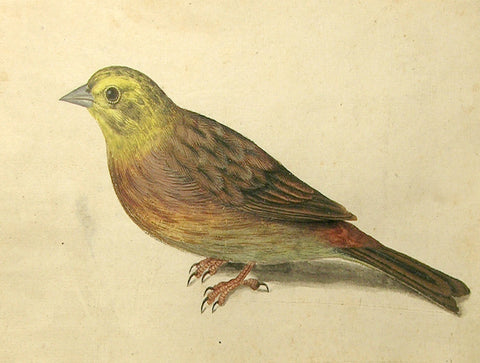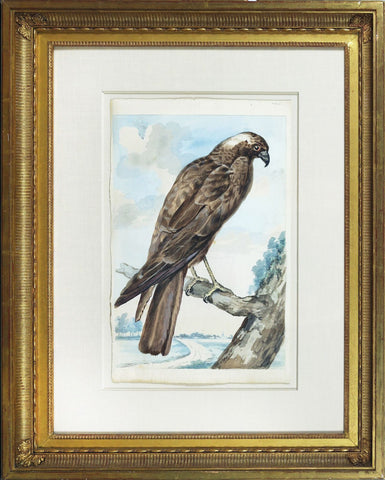
Jacques le Moyne de Morgues (French, ca. 1533-1588), Study of a Yellowhammer Bird
Jacques le Moyne de Morgues (French, ca. 1533-1588)
Study of a Yellowhammer Bird
Watercolor on vellum.
Vellum size: 8 1/4 x 6 in
Frame size: 16 1/2 x 18 3/4 in
The Yellowhammer bird has a convincing sense of three-dimensionality in its soft rendering and rich shading beneath the tail feathers. This work was acquired from a group of 27 watercolors by Le Moyne sold at Sotheby’s in January 2004. Subsequently, notable institutions have acquired watercolors from this grouping: the Metropolitan Museum of Art (A Kingfisher on a Branch and A Sheet of Studies of Flowers: A Rose, a Heartsease, a Sweet Pea, a Garden Pea, and a Lax-flowered Orchid) and the Getty Museum (A Sheet of Studies with French Roses and an Oxeye Daisy).
Interestingly, Le Moyne included both the Yellowhammer (Arader Gallery) and Kingfisher (the Met) on the same woodcut for the exceedingly rare La Clef des Champs (1586). The book was intended to aid artists in painting, embroidery, and tapestry. Thus, the book was handled a lot, and few copies survived intact. While the printed works are rather crude, their antecedents are beautifully executed.
Jacques Le Moyne de Morgues (FRENCH, ca 1533-1588)
The extraordinary career and oeuvre of the Huguenot artist Jacques Le Moyne de Morgues have only relatively recently been defined and described (see Paul Hulton, The Work of Jacques Le Moyne de Morgues, A Huguenot Artist in France, Florida, and England, 2 vols., London, 1977). The varied circumstances of his artistic production must surely be unique in the history of art; although large periods of his career are undocumented, he appears to have worked as a court artist in France, under Charles IX, is known to have traveled to Florida in 1564, as official artist and cartographer to the ill-fated French attempt to establish a colony there, and to have ended his career as a highly regarded botanical artist in Elizabethan London, where his patrons included Sir Walter Raleigh and Lady Mary Sidney.
Le Moyne was born around 1533, in Dieppe. The first thirty years of his life are undocumented, but it seems reasonable to suppose that he trained as an artist in his native town, which was at the time a notable center both for cartography and for illumination. Hulton believed that Le Moyne probably worked at the court of the French King Charles IX, although there is no documentary record to that effect. Le Moyne’s highly important account of his transatlantic voyage, known today from a Latin edition published in Frankfurt in 1591 under the title Brevis narratio eorum quae in Florida Americai provincia Gallis acciderunt, does, however, clearly indicate that it was the King who instructed the artist to accompany the expedition, headed by the notable mariners Jean Ribault and Rene Goulaine de Laudonniere, as official recording artist and cartographer. Although only one original drawing by Le Moyne of an American subject is known today -- the depiction of Athore showing Laudonniere the Marker Column set up by Ribault, executed in watercolor an gouache on vellum, now in the New York Public Library -- the Brevis narratio, published by Theodore de Bry as the second volume of his great series of publications on voyages to the New World, contains forty-two engraved illustrations and maps made on the spot by Le Moyne. The text fully describes and analyses these images, and this volume constitutes a major landmark in the literature of the early exploration of the Americas.
Laudonniere’s expedition, though resulting in the production of the fascinating Le Moyne/de Bry publication and an important map of the coastal regions of Florida, was ultimately a disaster; the good relations initially established with the Indian tribes inhabiting the territories around the settlement site at St. Johns soon soured, in addition to which various members of the French party became disaffected, and revolted against their leaders. The final coup de grace came when a Spanish force attacked Laudonniere’s stronghold at Fort Caroline, and in the end Le Moyne was one of only fifteen or so survivors of the original party to return safely to Europe; having lost their way, they sailed half-starved into Swansea Bay in mid-November 1565, and finally reached Paris early in 1566. But life in France soon became untenable, due to the Huguenot massacres, and in 1572 Le Moyne fled to England.
Until well into the present century, our knowledge of Jacques Le Moyne de Morgues was extremely limited, and largely confined to the footnotes of inaccessible ethnographic bibliographies, where he figures as the writer and illustrator of a short history of Laudonniere’s attempt between 1564 and 1565 to establish a Huguenot settlement in Florida. In 1922, however, Spencer Savage, librarian of the Linnean Society, made a discovery that opened the way to the subsequent definition of Le Moyne as an artistic personality; he recognized that a group of fifty-nine watercolors of plants contained in a small volume, purchased by the Victoria and Albert Museum in 1856 solely for its fine sixteenth-century French binding, were in fact by Le Moyne. Savage’s publications relating to this discovery prepared the way for subsequent attribution to the artist of other important groups of drawings and watercolors, the most notable being held by the British Museum and the Oak Spring Library, Virginia.
or by email at loricohen@aradergalleries.
We Also Recommend





